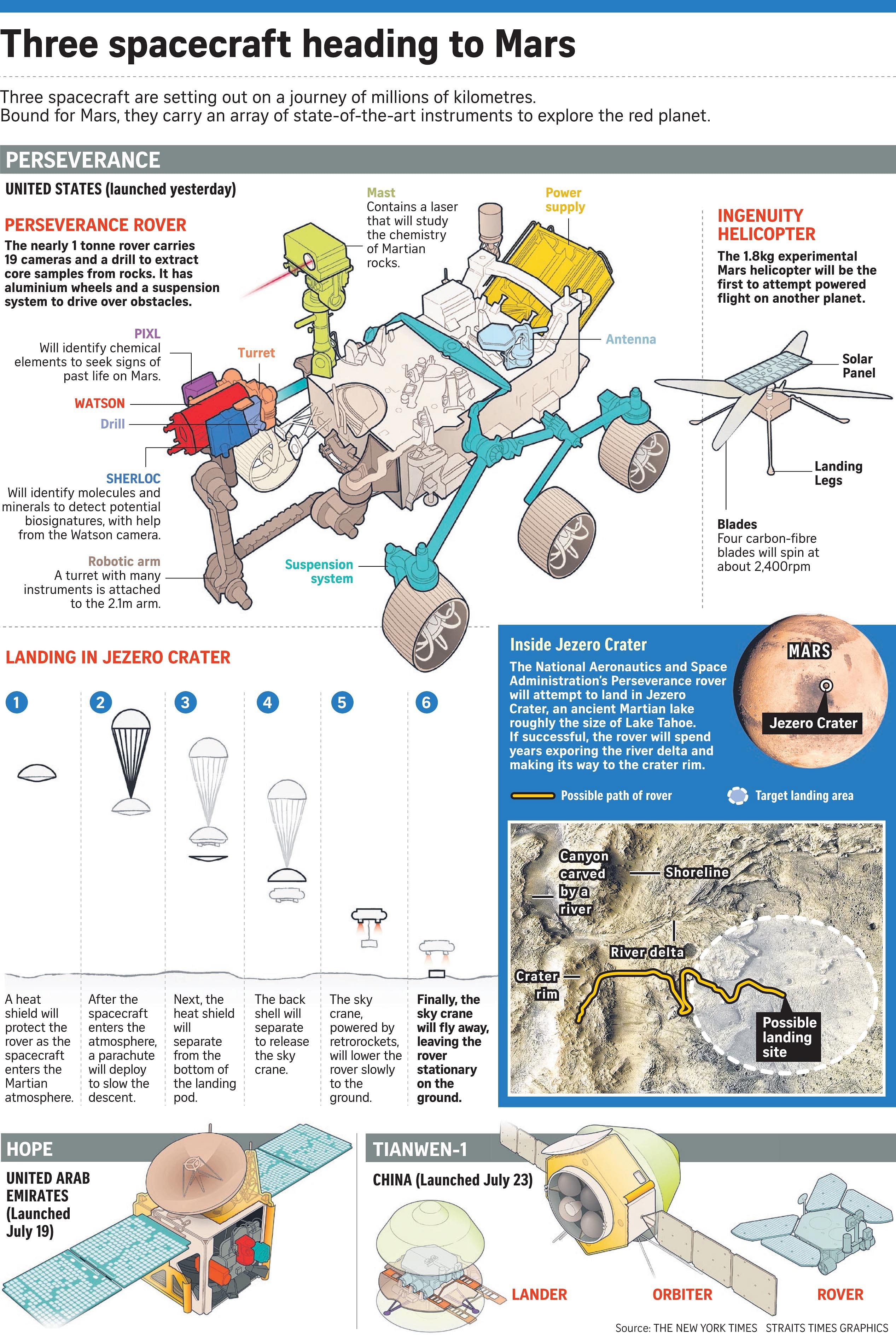CAPE CANAVERAL (Florida) • When Nasa's Perseverance rover arrives in Mars, mission managers will be watching, helpless to do anything.
The US$2.4 billion (S$3.3 billion) spacecraft will hit the top of the Martian atmosphere at more than 19,300kmh and then come to a complete stop seven minutes later.
That the one-tonne rover will end up on Mars on the afternoon of Feb 18 is nearly certain.
The next-generation Mars rover lifted off from Cape Canaveral yesterday on a mission to search for traces of potential past life on Earth's planetary neighbour.
It soared into the sky from the Cape Canaveral Air Force Station at 7.50am local time under clear, sunny and warm conditions, carried by an Atlas 5 rocket from Boeing-Lockheed joint venture United Launch Alliance.
The spacecraft's navigators will have put the robotic explorer on a collision course with the planet.
The only question is whether Perseverance will be on the ground in one piece or smashed to bits.
Spacecraft from Europe and the Soviet Union have made it all the way to the Red Planet, only to end up as expensive scorch marks on its dusty surface.
But the National Aeronautics and Space Administration has a good track record with Mars. It is the only space agency so far to pull off a successful mission on the surface of the Red Planet.
Perseverance is largely the same design as the Curiosity rover, which set down in 2012 and will have the same convoluted but now tried-and-true "sky crane" landing choreography.
"When people look at it, it looks crazy," Nasa engineer Adam Steltzner said in a video leading up to Curiosity's landing that described the components: heat shield, parachute, rocket engines and, finally, a hovering crane that lowered the rover to the surface.
"That's a very natural thing," he said. "Sometimes when we look at it, it looks crazy. It is the result of reasoned, engineering thought. But it still looks crazy."
While everything worked, the engineers got a chance to take a look at what could be improved this time around. "We don't usually get a chance to kind of redo or fix the mistakes we made last time," Dr Allen Chen, who leads the Perseverance entry, descent and landing team for Nasa's Jet Propulsion Laboratory, said in an interview.
For example, Curiosity actually landed too slowly, hitting the ground at 2.25kmh instead of the 2.73kmh that had been expected.
That, by itself, was not a problem. A softer landing is gentler on the spacecraft. But the engineers wanted to understand what had happened in order to make sure that the next landing - that of Perseverance - did not come down faster than intended. It turns out that their calculation of the gravity of Mars was slightly wrong.
In areas of the planet that possess less mass - like the 154km-wide crater that Curiosity landed in - the pull of gravity is a bit weaker.
"We didn't have sufficient fidelity in our gravity modelling to understand that the gravity there was actually different than elsewhere on the planet," Dr Chen said. "So that was one thing that we fixed."
Another component that was tweaked was the parachute that is unfurled when the spacecraft is hurling down at supersonic speeds.
A parachute failure in a prototype test of a future Mars landing system led Dr Chen's team to make sure it had not just gotten lucky with Curiosity.
"That gave us pause," he said.
The engineers are now confident of Perseverance's parachute after tests of a strengthened design.
One major addition to Perseverance is what Nasa calls "terrain-relative navigation". A camera on the spacecraft will take pictures of the landscape and match them with its stored maps. It would then steer to what looks like the safest landing spot it can.
"I don't need the whole place to be flat and boring," Dr Chen said. "I just need parts of it that I can reach to be flat and boring."
Without this system, there would be more than a one-in-five chance that Perseverance would end up somewhere unfortunate - damaged by a boulder, tipped over on a steep slope or surrounded by sand traps. That would be an unacceptably high risk for such a high-profile and expensive mission.
If it works, the same technology will be used when Nasa sends a mission to pick up the rock samples that Perseverance will be collecting, part of the so-called Mars sample return. That spacecraft will carry enough fuel that it is able not only to avoid obstacles but also to fly to a specific location, landing within tens of metres of the target.
Still, next Feb 18, the control room at the Jet Propulsion Laboratory is expected to be full of nervous engineers watching the telemetry returning from Perseverance. That data will take minutes to travel millions of kilometres - far too far and too slow for anyone at Nasa to make last-second corrections.
"Mars is not for the faint of heart," Dr Chen said.
NYTIMES, REUTERS

